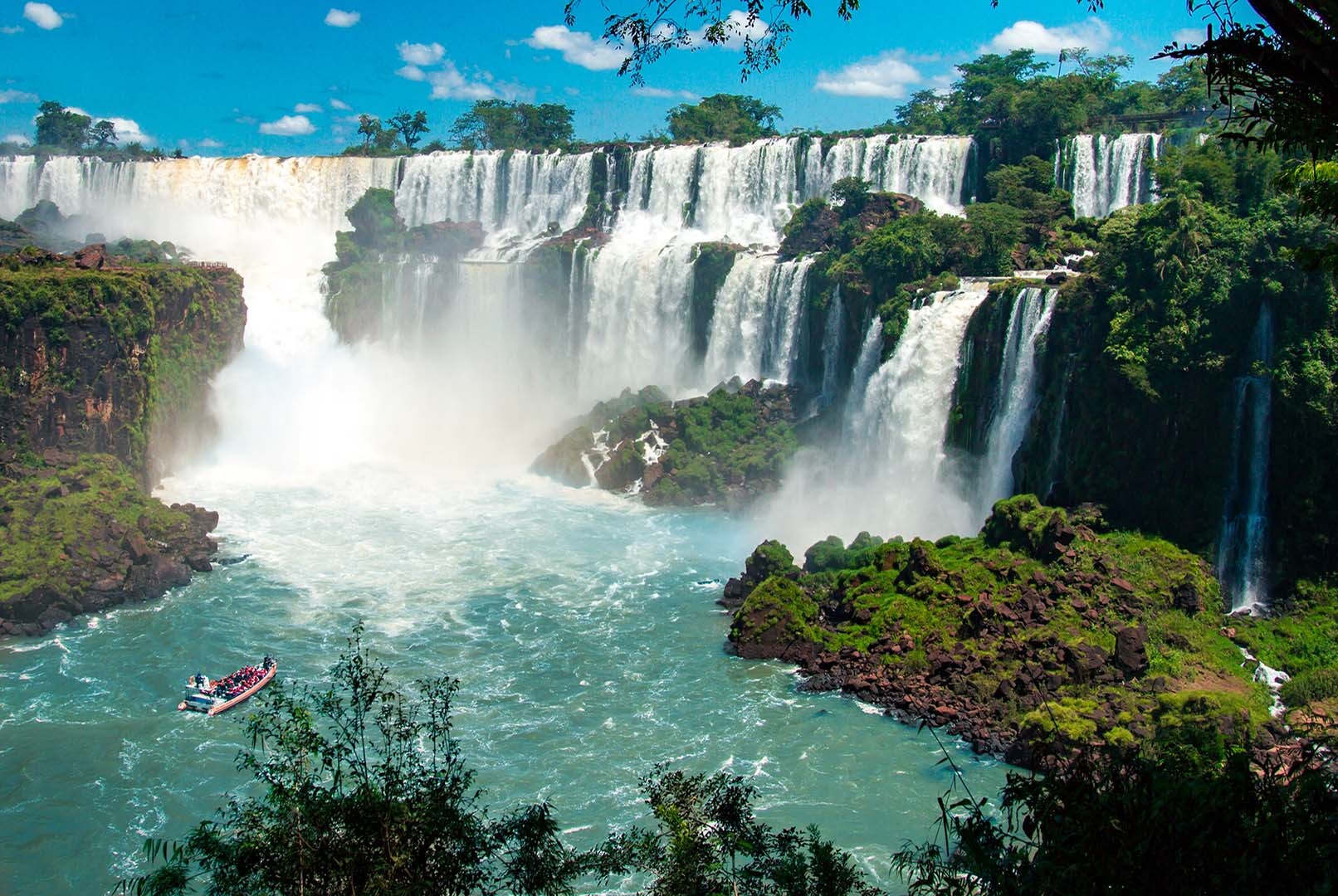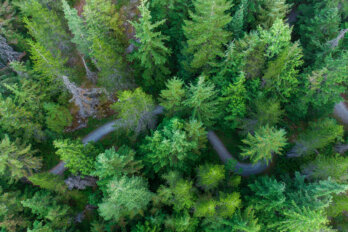Y WE TRAVEL
Why do we travel? For too long, we took this question for granted. Travel can make our large world small, and we forgot what a gift this is until it all got taken away from us not too long ago. Today, we’re returning to the skies in record numbers, but with a more appreciative mindset. It’s a perfect moment to take stock.The contributors to the “Y WE TRAVEL” series are accomplished writers from all walks of life. Over the length of this series, they will explore the diversity of purpose in our journeys—not just where or how, but why. On behalf of Toronto Pearson Airport and the Canadian Airports Council, please enjoy.
W e had climbed through clouds of exotic birds and electric-blue butterflies with the roar of water in our ears. The trees opened onto an unreal vista, the waterfalls of Iguazu stretching across two countries, as far as we could see. We were silent in the face of this majesty, until my friend Kim said: “You know, I’ve never seen a toucan outside a cereal box.”
Ok, so it wasn’t a “one small step for man” moment, but Kim had articulated something we were all feeling. If we’d stayed at home, that vista would have remained as unreal, as artificial, as a picture on a cereal box. The Iguazu Falls, sitting at the intersection of Brazil and Argentina, offer a site of unparalleled beauty – as well as an offhand disregard for human safety that thrilled my careful Canadian soul. “Peligro,” warned the sign over the precipitous drop to rushing water. There was no fence, no chain. Live or die, it seemed to suggest. The falls will keep falling.
As we picked our way back down the slippery stones, trying to ignore the floral tributes to those who had perhaps underestimated the severity of the peligro, I wanted more. I felt awe, both for the beauty of nature, dwarfing the gossamer thread of my mortality, and for the human ingenuity that harnessed the power of the water.
“Travel catapults you clear of the mundane, from your daily commute and the same takeout menu you’ve stared at 600 times. It kick-starts your brain.”
Isn’t that why we travel, to be struck wordless by wonder? To marvel at the natural world, and be astonished by the creativity that has shaped it? I’m not talking about visiting multi-level malls or Michelin-starred restaurants, but discovering the hidden and magical, the places where new perspectives open up before your eyes and in your imagination. I’ve found that sense of amazement in the oddest places: Stroking the soft nose of a champion thoroughbred at the Kentucky Horse Park, or feeling the silence cocoon my ears in Chile’s Atacama Desert, like the world’s largest and most comforting duvet.

Where We Travel
As an architect, program manager and airport executive, I’ve been lucky enough to spend time in hundreds of airports over 30 years in the airport business. Some of my favorites include Singapore Changi (a city destination in itself), Doha Hamad in Qatar (the architecture, art and amenities support incredible passenger experience) and Schiphol in Amsterdam (the original hub), which I use often for my European travels.
Everyone who travels focuses on a different part of the airport experience. What I look at is how they meet their passengers’ wants and needs. As I write, airports in Montreal, New York, Los Angeles, Chicago, Dubai and Singapore are all working on multi-billion-dollar infrastructure upgrades. They can see that global demand is soaring, that passengers have heightened expectations and that new technologies have the potential to revolutionize experience and sustainability.
These are some of the lessons we’re bringing back to Toronto Pearson (YYZ), where we’re embarking on an ambitious infrastructure program called Pearson LIFT. It’s a decade-long project to modernize, digitalize and expand Canada’s largest airport. Our annual passenger volume is projected to increase from 45 million to 65 million by the early 2030s, and our terminals, runways and facilities need to be ready. We’re also future-proofing for sustainability, using circular materials and modern design to accommodate climate-friendly aviation – modern airplanes, sustainable fuels, electric vehicles, energy-efficient lighting, solar generation, low-emissions heating and cooling systems.
– Bernardo Gognachief infrastructure officer, Toronto Pearson
You don’t need to traverse dangerous waterfalls to find awe. It is everywhere, provided you know where to look. In Berlin one summer afternoon, I lay floating on my back in the Teufelssee, one of the many lakes that dot the German capital, trying to avert my eyes from the freikoerperkultur bathers skinny-dipping around me. With the trees of the Grunewald pressed around us, we were lost in time. I half expected to hear the horns of a medieval hunting party pursuing a stag nearby.
Except, a few hills over, the eerie skeleton of an abandoned American spy station looms on top of Teufelsberg, the Devil’s Hill. You can dry yourself off and hike from medieval Germany to Cold War Germany in little more time than it takes to drink a can of pilsner. We climbed the hill, built on the rubble of a Nazi military college, and wandered around the graffitied ruins where the West had eavesdropped on secrets they hoped would bring the Soviet Union to its knees. All around us were the trees of the Green Forest, silent but possibly secretly laughing at the hubris of the humans in their midst.
In theory, we can experience that same sense of wonder and awe close to home. But without the unfamiliar, the thrill that comes with discovery, it’s a lot more difficult. Travel catapults you clear of the mundane, from your daily commute and the same takeout menu you’ve stared at 600 times. It kick-starts your brain.
Travel also allows you to make unusual connections, to escape the tyrannical algorithms that govern our online lives. It offers serendipity, the delight of opening up to chance. I had one of those revelatory moments in a small village in the Philippines, in the north of the island of Luzon. The village lay cupped in the staggering beauty of the Banaue rice terraces—ancient stepped agricultural fields originally planted and harvested cooperatively by the Ifugao people. Unbeknownst to me, the village was celebrating a harvest: a water buffalo was led into the crowded central square and then sacrificed. The buffalo lumbered to its knees and toppled over.
I was suffering from food poisoning at the time, and peeked between scrunched eyelids as the villagers efficiently and cheerfully butchered the animal, distributing all the meat until every family had some. Even the village dogs got to snuffle up the leftovers. My mind travelled back to my visit to the Marikina Shoe Museum near Manila, where Imelda Marcos’s glittering designer pumps were on display: the shoes that the dictator’s wife had used to metaphorically kick her people in the teeth, as she and her husband Ferdinand stole the country’s wealth. And here, in the hills of Banaue, the exact opposite was happening: a fair and just distribution of resources.
Would I ever have made those connections if I hadn’t been able to travel to the Philippines? Would I have spared a single thought for the way hydroelectricity is produced if I hadn’t found myself caught in a web of awe and wonder in the jungles of South America? (Spoiler alert: I would not.) I could have read a dozen books about the Cold War and not experience the same frisson I felt standing with the ghosts of spies on top of Devil’s Hill in Berlin.
While I’m still alive, while my eyes are capable of opening and my brain of feeling amazement, you’ll find me on the road. Because the world is full of wonder and surprise, even if you have to stretch to find it.
Elizabeth Renzetti is a Canadian-British journalist and bestselling author of four books.




